Rainforests, Waterfalls and Caribs

Lochmarin
Fri 5 Apr 2013 22:12
Along with the Tulus (everyone gets to be known by the name of their boat) and a lovely Finnish couple we'd not met before, we took a day trip out with Winston in his people carrier to see more of the Island, and in particular to search for parrots. 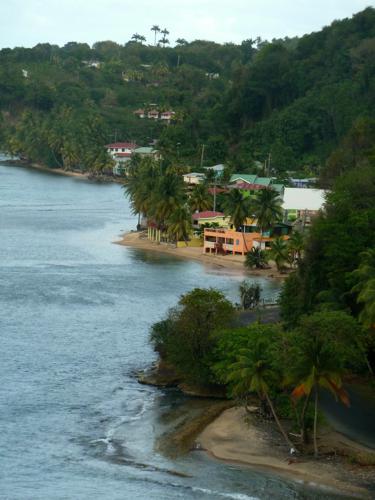 We started by driving South along the spectacular coast road. When we had sailed North past the Island and I saw the villages clinging to the hillsides I wondered how on earth one got to them. We found out. The road dropped into valleys that dipped down to the sea, in order to cross rivers and streams, then wound behind headlands before finding the sea again and clinging precariously to the edge of cliffs running along the coast. The road was surprisingly wide and in good condition, we found out that it had been constructed by the Chinese, literally, they sent over plant and workers, as part of four payback projects they had promised Dominica for cutting diplomatic contact with the Taiwanese. Money seems to come from unlikely places here: an apartment complex we saw being built was funded by Morocco, while the cooperative packaging plant by the jetty in Portsmouth was funded by the European Union. 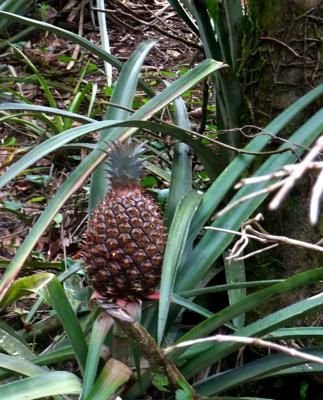 We soon headed off the main road inwards and upwards, climbing steeply along a ridge, slowing right down every now and again to cross a stream that poured over the road. All around us were small holdings, from a couple of acres to as big as 10 acres. The crops are intermingled: coffee, guava, nutmeg, yams, banana, plantain, mangoes, citrus and coconut. The bananas were under the coconut trees, corn wherever a bit of flat land could be found, coffee along the road side, yam vines climbing sticks from their mounds of earth like mole hills and whenever there was a spare bit of space pineapples were sprouting, looking much too heavy for the little spray of leaves beneath them. The only crop we saw planted as a single field was the calaloo, a spinach type plant with an edible starchy root, dasheen. The Tulus had tried cooking dasheen and ended up with something that looked and tasted like wallpaper paste. However, whenever we have had 'lunch' out (you get different types of lunch: fish lunch or chicken lunch, sometimes curried chicken lunch. They all come with a selection of local vegetables: yam, dasheen, plantain, breadfruit, along with tomatoes and coleslaw) the dasheen hasn't been slimy, it's been a tad dry actually, so there must be a secret to cooking it. They say that if you put a stick into the ground on Dominica or spit out a seed from some fruit it will grow. I believe it! But what I couldn't help thinking about was the massive amount of work it must be to keep the wild plants at bay here, everything grows so readily. Weeding must be a nightmare... and we complain about bindweed!  Calaloo growing with the rainforest on the slopes behind. As we got higher Winston started stopping the car and listening for the parrots, he showed us the trees they liked the seeds from, he stopped to ask smallholders if they'd seen any that morning. At last we got out and started walking to try to find them, we could hear them above us and we could see fruit on the trees they'd been eating but green parrots against green trees remained elusive. 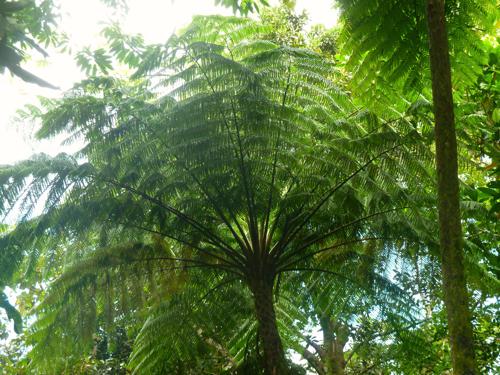  Fern trees above us and a parrot eaten orange! Still, it was no hardship as the rainforest around us just took our breath away. The sheer height and size of the trees, with aerial roots hanging down the length of them and the Epiphytes taking advantage of every nook and cranny to get a foothold. These ferns and air plants (remember? There was a phase of having them for Christmas presents? Little plants on shells that you could put in your bathroom to live without soil?) are everywhere, decorating the trunks of living and fallen trees, along with the ivies that criss cross their way up the trees. 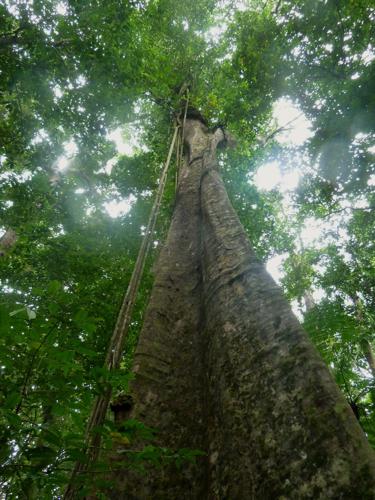 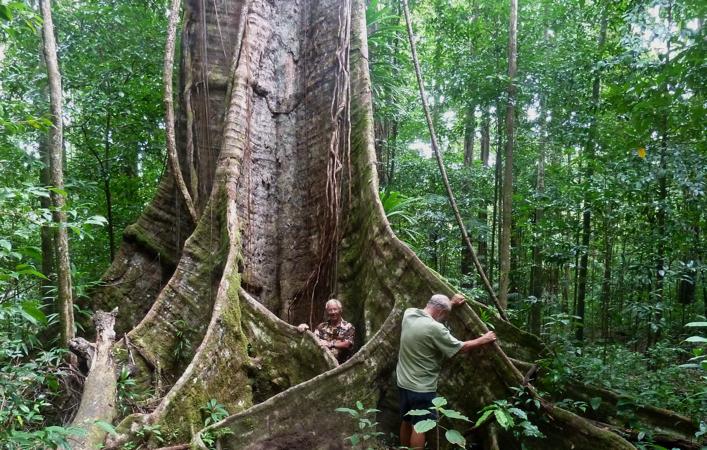 All the time we heard the screech of the parrots, along with the haunting call of the mountain whistler bird (the Siffleur Montagne. Dominica used to be French, then the British took it over, so place names and creature names are French, and the patois is Creole, which is mostly a sort of French, yet the national language is English.. all very confusing!). It was magical to be in a rainforest. I'd grown up on wildlife documentaries and watched David Attenborough lose his hair and get out of breath over the years, so actually standing in one was wonderful.  We moved on, going further North and East and taking a quick stop to buy some fruit from a road side stall - very welcome as we'd been up before dawn setting a second anchor as we were concerned to leave the boat on just one if we were to be away the whole day. The red bananas were the best bananas we had every tasted, definitely a must if you ever come across them. 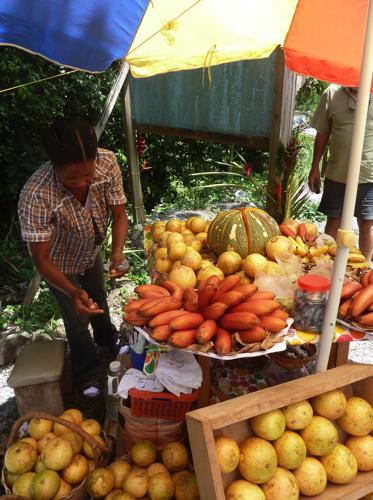 We stopped at Spanny Falls, grabbing roasted chicken and johnny cakes in the store to keep us fortified. We trekked into the forest, heading downhill with the bank alongside us getting steeper and higher until we were walking alongside a cliff covered in ferns and dripping water onto us. This led to a waterfall cascading over the top into a plunge pool below before swirling around the boulders and sliding off downstream. 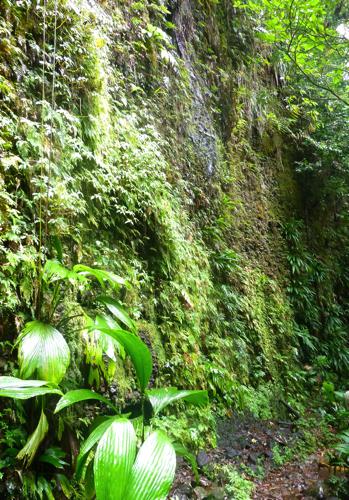 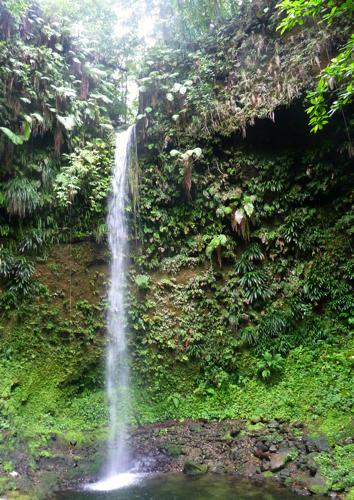 This was magical enough but beyond the first pool there was a rope tied to the trees going up the cliff. You have to scramble up the cliff using the rope to hold on to. It's about 30ft up, I'd guess. Over the top there's a similar drop down then a bit of a scramble along a gully, again with ropes to hold onto, and you find yourself at a second waterfall. The peace and beauty of these falls defeats my descriptive ability. We didn't take the camera to the second fall as I didn't want a bag on my back whilst climbing so you will just have to use your imagination. We were soaked to the skin already (they don't call it the rainforest for nothing, we discovered) so we simply striped to underwear and swam in the wonderful cool clear water, feeling the pull as it rushed past us, and enjoying the change from our daily dips in sea water. From here we drove North to the Carib reservation. The Carib are the indigenous people of the Island. There are very few true Carib left and so it was a real treat to meet some of them and see a little of their way of life. They look very different from the rest of the Caribbean folk, lighter skinned and looking Amerindian, more like Inuit. A very handsome race. They are great weavers, using a reed that grows locally, and we were privileged to see them constructing a traditional dugout from a tree they had brought from the rainforest. they took 4 days to fid the right tree and many weeks to cut it down, dig out the bulk of the inside, and drag it from the forest, all by hand. Regina coordinated the whole operation, the only woman on the expedition, pulling and lifting along with the men. 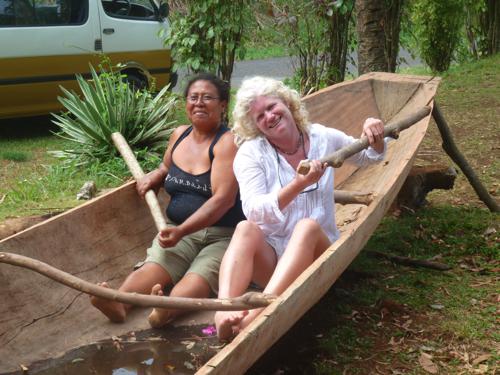 Regina, project manager. Just by the canoe was a cashew tree. We'd seen these in flower in Grenada but had yet to see them in fruit. They have an 'apple' which grows above the nut, which is enclosed in a green waxy covering.  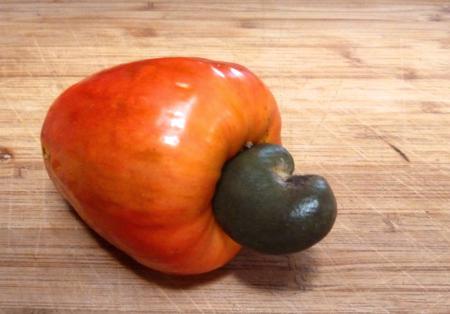 The nut is poisonous - rather like poisoned ivy, even the fumes are poisonous when you burn it, but the poison is broken down by roasting. The problem is, cashew oil is flammable so the roasting is a tricky process, you have to get it hot enough to roast yet not set the oil alight or your whole crop turns to charcoal. No wonder cashews are expensive nuts. The apple part is edible, and is amazingly juicy, it's like those adverts for kitchen paper, they hold an improbable amount of liquid. Some say the waxy skin has an irritant in it, and you should steam it to break it down, so we just drank the juice, which was astringent but delicious. We drove back around the Northern coast, stopping for some lunch in a cafe that overlooked a valley running down to the sea. There, whilst we were eating, as well as seeing hummingbirds, bananaquits, lizards and iguanas, we saw a parrot come flying across from one side to the other. Finally we saw one! The rugged Northern coast was the set for a lot of the Pirates of the Caribbean films, easy to believe seeing the beautiful beaches and jagged islands. 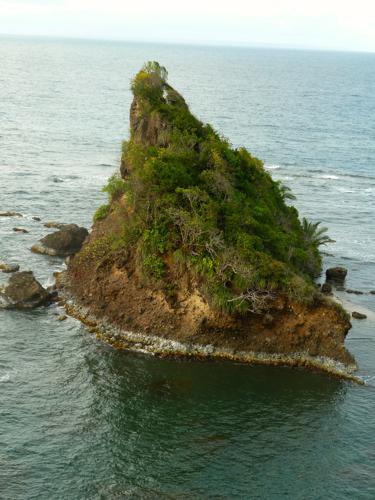 At one point we slipped off the 'main' road onto a single track smaller road, running along a ridge. Immediately Winston speeded up - which wouldn't have been my reaction to a narrow road with a drop either side, but he was diverting to show us his village, which runs along the top of a ridge, and he was on the home straight. The village was beautiful, houses either side of the single road, behind them the valleys dropping steeply, with bars, a shop and a school. A youngster scrambled to grab his puppy and get out of the road as we approached, Winston greeting him by name - everyone knew everyone. What an idyllic place to grow up. We didn't take Spike, as we were a little concerned that he'd want to join his wild cousins and we'd lose him for ever, but have promised him an outing later this week.  |